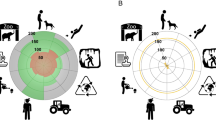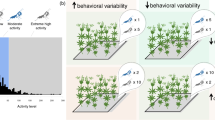Abstract
As invasion science accepts that there is no single causal factor for biological invasion, the identification of groups of traits that are often associated, or “syndromes”, is a logical move forward. Invasion syndromes are proposed to identify suites of site conditions (biotic and environmental) that render a site vulnerable to invasion by different types of invaders. This paper proposed four invasion syndromes which relate invader attributes (competitive ability, niche construction, phenotypic plasticity, and phenological niche separation) to the biotic characteristics (biodiversity and enemies) and environmental conditions (resource abundance and fluctuation) of invaded sites. The four invasion syndromes described in this paper are a development of hypotheses of how the many factors that influence species invasion might be associated. Invasion Syndrome 1 proposes that sites with relatively high resource abundance and high diversity should be vulnerable to invasion by species with high competitive ability. Invasion Syndrome 2 hypothesizes that sites with relatively low resource abundance and low diversity should be vulnerable to invasion by species with niche construction ability. Invasion Syndrome 3 postulates that sites with moderate or fluctuating resources and moderate diversity should be vulnerable to invasion by species with high phenotypic plasticity. Invasion Syndrome 4 hypothesizes that species introduced into a site where it has phenological niche separation from natives will not have to contend with interference from the biotic community at a site (diversity or natural enemies) and may invade where ever site environmental conditions suit its life history. Further work is needed to support, contradict, or refine these hypotheses and almost certainly will identify more invasion syndromes.
Similar content being viewed by others
References
Alpert P, Bone E, Holzapfel C. 2000. Invasiveness, invasibility and the role of environmental stress in the spread of non-native plants. Perspectives in Plant Ecology Evolution and Systematics, 3: 52–66.
Baker H. 1974. The evolution of weeds. Annual Review of Ecology and Systematics, 5: 1–24.
Barney J N, Whitlow T H. 2008. A unifying framework for biological invasions: the state factor model. Biological Invasions, 10: 259–272.
Bertness M D, Callaway R. 1994. Positive interactions in communities. Trends in Ecology & Evolution, 9: 191–193.
Blossey B, Notzold R. 1995. Evolution of increased competitive ability in invasive nonindigenous plants: a hypothesis. Journal of Ecology, 83: 887–889.
Caldow R W G, Stillman R A, Durell S A D, et al. 2007. Benefits to shorebirds from invasion of a non-native shellfish. Proceedings of the Royal Society B: Biological Sciences, 274: 1449–1455.
Catford J A, Jansson R, Nilsson C. 2009. Reducing redundancy in invasion ecology by integrating hypotheses into a single theoretical framework. Diversity and Distributions, 15: 22–40.
Catford J A, Vesk P A, White M D, et al. 2011. Hotspots of plant invasion predicted by propagule pressure and ecosystem characteristics. Diversity and Distributions, 17: 1099–1110.
Chytry M, Jarosik V, Pyšek P, et al. 2008. Separating habitat invisibility by alien plants from the actual level of invasion. Ecology, 89: 1541–1553.
Cuddington K, Hastings A. 2004. Invasive engineers. Ecological Modeling, 178: 335–347.
Cuddington K, Wilson W G, Hastings A. 2009. Ecosystem engineers: feedback and population dynamics. The American Naturalist, 173: 488–498.
Cushman J H, Lortie C J, Christian C E. 2011. Native herbivores and plant facilitation mediate the performance and distribution of an invasive exotic grass. Journal of Ecology, 99: 524–531.
D’Antonio C M. 1993. Mechanisms controlling invasion of coastal plant communities by the alien succulent Carpobrotus edulis. Ecology, 74: 83–95.
Davidson A M, Jennions M, Nicotra A B. 2011. Do invasive species show higher phenotypic plasticity than native species and, if so, is it adaptive? A meta-analysis. Ecology Letters, 14: 419–431.
Davis M, Chew M K, Hobbs R J, et al. 2011. Don’t judge species on their origins. Nature, 474: 153–154.
Davis M A, Grime J P, Thompson K. 2000. Fluctuating resources in plant communities: a general theory of invasibility. Journal of Ecology, 88: 528–534.
Deckers B, Verheyen K, Hermy M. 2005. Effects of landscape structure on the invasive spread of black cherry Prunus serotina in an agricultural landscape in Flanders, Belgium. Ecography, 28: 99–109.
Drenovsky R E, Khasanova A, James J J. 2012. Trait convergence and plasticity among native and invasive species in resource-poor environments. American Journal of Botany, 99: 629–639.
Elton C. 1958. The Ecology of Invasions by Animals and Plants. Chicago: University of Chicago Press.
Eviner V T, Garbach K, Baty J H. 2012. Measuring the effects of invasive plants on ecosystem services: challenges and prospects. Invasive Plant Science and Management, 5: 125–136.
Farrer E C, Goldberg D E. 2009. Litter drives ecosystem and plant community changes in cattail invasion. Ecological Applications, 19: 398–412.
Goldberg D E, Landa K. 1991. Competitive effect and response: hierarchies and correlated traits in the early stages of competition. Journal of Ecology, 79: 1013–1030.
Hart S P, Marshall D J. 2012. Advantages and disadvantages of interference-competitive ability and resource-use efficiency when invading established communities. Oikos, 121: 396–402.
He Q, Cui B S, An Y. 2012. Physical stress, not biotic interactions, preclude an invasive grass from establishing in forb-dominated salt marshes. PLos One, 7: e33164.
Holmquist J G, Schmidt-Gengenbach J, Slaton M R. 2011. Influence of invasive palms on terrestrial arthropod assemblages in desert spring habitat. Biological Conservation, 144: 518–525.
Jeschke J M, Gómez Aparicio L, Haider S, et al. 2012. Support for major hypotheses in invasion biology is uneven and declining. NeoBiota, 14: 1–20.
Jones C G, Lawton J H, Shachak M. 1994. Organisms as ecosystem engineers. Oikos, 69: 373–386.
Keane R M, Crawley M J. 2002. Exotic plant invasions and the enemy release hypothesis. Trends in Ecology & Evolution, 17: 164–170.
Kennedy T A, Naeem S, Howe K M, et al. 2002. Biodiversity as a barrier to ecological invasion. Nature, 417: 636–638.
Kylafis G, Loreau M. 2008. Ecological and evolutionary consequences of niche construction for its agent. Ecology Letters, 11: 1072–1081.
Kylafis G, Loreau M. 2011. Niche construction in the light of niche theory. Ecology Letters, 14: 82–90.
Larson D L, Anderson P J, Newton W. 2001. Alien plant invasion in mixed-grass prairie: effects of vegetation type and anthropogenic disturbance. Ecological Applications, 11: 128–141.
Levine J M. 2000. Species diversity and biological invasions: relating local process to community pattern. Science, 288: 852–854.
Levine J M, Vilà M, Antonio C M D. 2003. Mechanisms underlying the impacts of exotic plant invasions. Proceedings of the Royal Society of London Series B: Biological Sciences, 270: 775–781.
Levine J M, Adler P B, Yelenik S G. 2004. A meta-analysis of biotic resistance to exotic plant invasions. Ecology Letters, 7: 975–989.
Lockwood J L, Cassey P, Blackburn T. 2005. The role of propagule pressure in explaining species invasions. Trends in Ecology & Evolution, 20: 223–228.
MacDougall A S, Boucher J, Turkington R. 2006. Patterns of plant invasion along an environmental stress gradient. Journal of Vegetation Science, 17: 47–56.
Mack R N, Simberloff D, Lonsdale W M, et al. 2000. Biotic invasions: causes, epidemiology, global consequences, and control. Ecological Applications, 10: 689–710.
Maestre F T, Callaway R M, Valladares F, et al. 2009. Refining the stress-gradient hypothesis for competition and facilitation in plant communities. Journal of Ecology, 97: 199–205.
Maron J L, Vilà M. 2001. When do herbivores affect plant invasion? Evidence for the natural enemies and biotic resistance hypotheses. Oikos, 95: 361–373.
Molina-Montenegro M A, Penuelas J, Munne-Bosch S, et al. 2012. Higher plasticity in ecophysiological traits enhances the performance and invasion success of Taraxacum officinale (dandelion) in alpine environments. Biological Invasions, 14: 21–33.
Oksanen L, Oksanen T. 2000. The logic and realism of the hypothesis of exploitation ecosystems. American Naturalist, 155: 703–723.
Olech M, Chwedorzewska K J. 2011. The first appearance and establishment of an alien vascular plant in natural habitats on the forefield of a retreating glacier in Antarctica. Antarctic Science, 23: 153–154.
Palacio-Lopez K, Gianoli E. 2011. Invasive plants do not display greater phenotypic plasticity than their native or non-invasive counterparts: a meta-analysis. Oikos, 120: 1393–1401.
Perkins L B, Leger E A, Nowak R S. 2011. Invasion triangle: an organizational framework for species invasion. Ecology and Evolution, 1: 610–625.
Perkins L B, Nowak R S. 2013. Native and non-native grasses generate common types of plant-soil feedbacks by altering soil nutrients and microbial communities. Oikos, 122: 199–208.
Pichancourt J B, van Klinken R D. 2012. Phenotypic plasticity influences the size, shape and dynamics of the geographic distribution of an invasive plant. PLos One, 7: 12.
Pyšek P, Jarosik V, Hulme P E, et al. 2012. A global assessment of invasive plant impacts on resident species, communities and ecosystems: the interaction of impact measures, invading species’ traits and environment. Global Change Biology, 18: 1725–1737.
Rees M, Condit R, Crawley M, et al. 2001. Long-term studies of vegetation dynamics. Science, 293: 650–655.
Richards C L, Bossdorf O, Muth N Z, et al. 2006. Jack of all trades, master of some? On the role of phenotypic plasticity in plant invasions. Ecology Letters, 9: 981–993.
Richardson D M, Pyšek P, Rejmanek M, et al. 2000. Naturalization and invasion of alien plants: concepts and definitions. Diversity and Distributions, 6: 93–107.
Richardson D M, Pyšek P. 2006. Plant invasions: merging the concepts of species invasiveness and community invasibility. Progress in Physical Geography, 30: 409–431.
Schweiger O, Biesmeijer J C, Bommarco R, et al. 2010. Multiple stressors on biotic interactions: how climate change and alien species interact to affect pollination. Biological Reviews, 85: 777–795.
Shea K, Chesson P. 2002. Community ecology theory as a framework for biological invasions. Trends in Ecology & Evolution, 17: 170–176.
Stohlgren T J, Barnett D T, Kartesz J. 2003. The rich get richer: patterns of plant invasions in the United States. Frontiers in Ecology and the Environment, 1: 11–14.
Stohlgren T J, Crosier C, Chong G W, et al. 2005. Life-history habitat matching in invading non-native plant species. Plant and Soil, 277: 7–18.
van de Koppel J, Huisman J, van der Wal R, et al. 1996. Patterns of herbivory along a productivity gradient: an empirical and theoretical investigation. Ecology, 77: 736–745.
Vilà M, Weiner J. 2004. Are invasive plant species better competitors than native plant species? Evidence from pair-wise experiments. Oikos, 105: 229–238.
Von Holle B, Simberloff D. 2005. Ecological resistance to biological invasion overwhelmed by propagule pressure. Ecology, 86: 3212–3218.
Walker S, Wilson J B, Lee W G. 2005. Does fluctuating resource availability increase invasibility? Evidence from field experiments in New Zealand short tussock grassland. Biological Invasions, 7: 195–211.
Wardle D A. 2001. Experimental demonstration that plant diversity reduces invasibility-evidence of a biological mechanism or a consequence of sampling effect? Oikos, 95: 161–170.
Wolkovich E M, Cleland E E. 2011. The phenology of plant invasions: a community ecology perspective. Frontiers in Ecology and the Environment, 9: 287–294.
Author information
Authors and Affiliations
Corresponding author
Rights and permissions
About this article
Cite this article
Perkins, L.B., Nowak, R.S. Invasion syndromes: hypotheses on relationships among invasive species attributes and characteristics of invaded sites. J. Arid Land 5, 275–283 (2013). https://doi.org/10.1007/s40333-013-0161-3
Received:
Revised:
Accepted:
Published:
Issue Date:
DOI: https://doi.org/10.1007/s40333-013-0161-3




